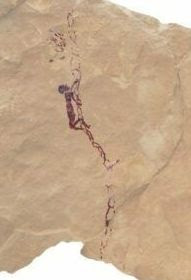Sorry, I just could not resist, but finding this report was really a sweet experience. It shows a honey gatherer climbing a rope to gain access to a beehive in Spain. “Within the foothills of the Iberian System Mountain Range in northeastern Spain, archaeologists have discovered a 7,500-year-old painting depicting prehistoric humans gathering honey. The exceptionally detailed image shows a figure climbing a rope ladder to reach a colony of bees.” (Saed 2021)
“Manuel Bea, a researcher from the University of Zaragoza, authenticated the painting alongside colleagues Ines Domingo and Jorge Angas. ‘We have a perfect photograph,’ he explains, that provides insight into just how these practices were conducted: by climbing ropes. The Barranco Gomez rock shelter was found by a nearby resident in 2013, but the analysis of the painting published just this year.” (Saed 2021)
“Alongside the honey painting, two others were discovered at the Barranco Gomez site, including a scene depicting a pair of archers and an image of a hind, a female red deer, on the run. The paintings, Bea explains, are reminders of the ingenuity of human evolution.” (Saed 2021)
The red-painted pictograph shows a honey hunter climbing a rickety rope ladder with a cloud of dots which we assume represent the cloud of wild bees nesting high in an opening in a cliff.
Drawings of honey gatherer from Cuevas de las Arañas, (left) by Eduardo Hernandez. Both from Bogard, 2021, The Araña Caves of Valencia: Entering a Bygone Era Through Rock Art, 6 July 2021.
“The Cuevas de la Araña (known in English as Araña Caves or the Spider Caves) are a group of caves in the municipality of Bicorp in Valencia, eastern Spain. The Caves are in the valley of the river Escalona and were used by prehistoric people who left rock art. They are known for painted images of a bow and arrow goat hunt and for a scene depicting a human figure.” (Wikipedia) This scene also illustrates a human figure climbing up ropes to a hole in a cliff, carrying a basket and surrounded by a cloud of flying bees.
“The dating of such art is
controversial, but the famous honey-gathering painting is believed to be epipaleolithic
and is estimated to be around 8000 years old.” (Wikipedia)
The remarkable similarities in these two panels, so near to each other in dating, illustrate how important honey-gathering was to the people of that era.
NOTE: Some images in this posting were retrieved from the internet with a search for public domain photographs. If any of these images are not intended to be public domain, I apologize, and will happily provide the picture credits if the owner will contact me with them. For further information on these reports you should read the original reports at the sites listed below.
REFERENCE:
Bea, M., Domingo, I. Angas, J., 2021, Descubierta en un abrigo de Castellote la mejor representacion de recolectores de miel del Arte Levantino, https://heraldo.es/noticias/aragon/teruel/2021/07/07/Descubierta-en-un-abrigo-de-Castellote-la mejor-representacion-de-recolectores-de-miel-del-Arte-Levantino
Bogard, Cecilia, 2021, The Araña Caves of Valencia: Entering a Bygone Era Through Rock Art, 6 July 2021, https://www.ancient-origins.net/ancient-places-europe/ara-caves-0015539
Saed, Omnia, 2021, Found: A 7,500-Year-Old Cave Painting of Humans Gathering Honey, 16 December 2021, Atlas Obscura, https://atlasobscura.com/articles/honey-cave-painting
Wikipedia, Cuevas de la Araña, https://en.wikipedia.org/wiki/Cuevas_de_la_Araña, accessed 5 January
2022.










No comments:
Post a Comment